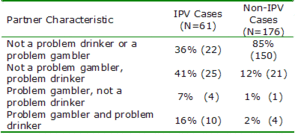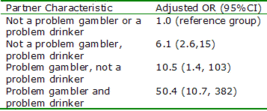Excessive gambling can introduce many problems into the home including intimate partner violence (IPV). This week’s WAGER examines a study designed to empirically test the relationship between problem gambling and IPV (Muelleman, DenOtter, Wadman, Tran, & Anderson, 2002).
Mueleman et al.’s study sample consisted of women aged 19 to 65 who were admitted to the emergency department at the University Hospital of Nebraska Health System. A researcher was stationed in the emergency department for random four- or eight-hour blocks covering each day of the week from June to August, 1999. The researcher approached 300 women who met inclusion criteria (i.e., not decisionally incapacitated, not incapacitated by illness, and spoke English) and 286 agreed to participate in the study. In a private room, the researcher read a 45-item questionnaire to each participant that included questions on relationship status and IPV. Answering as they thought their partner would, women completed the South Oaks Gambling Screen (Lesieur & Blume, 1987) to assess problem gambling in the partner and the CAGE Instrument (Ewing, 1984) to assess problem drinking in the partner. Women without an intimate partner in the past year (N=49) were excluded from analyses.
Of the 61 women reporting IPV, 14 (23%) had partners who were classified as problem gamblers (Table 1). Ten of the 14 IPV problem gamblers also had a drinking problem. The researchers used logistic regression to test whether a partner’s problem gambling related to IPV. After adjusting for age, education and ethnicity, a woman whose partner was a problem gambler was 10.5 times more likely to be a victim of IPV (Table 2). The likelihood of experiencing IPV was even greater (OR = 50.4) when the partner had both a gambling and a drinking problem.
Table 1. Distribution of Partner’s Alcohol and Gambling Status (adapted from Muelleman et al., 2002)
Table 2. Adjusted Odds Ratio Estimates for Risk of IPV for Women According to Partner Characteristics
(adapted from (Muelleman et al., 2002)
One weakness of this study is that women evaluated problem gambling and problem drinking in their partner. The SOGS and CAGE instruments are meant to be completed by the patient, not his partner, and neither instrument has been validated for use by a second party. Both instruments call for an emotional evaluation, and it could be argued that only the patient has knowledge of how he feels. For example, the CAGE asks “Have you ever felt bad or guilty about your drinking?”; the SOGS asks a parallel question about gambling. The women in this study may have over or underestimated their partners’ gambling and drinking behavior leading to misclassification. In addition, the findings might not be generally applicable to the larger population because of the small number (5) of partners with only a gambling problem. Another limitation is that the researchers considered only heterosexual IPV by defining the intimate partner as a “male with whom the patient considers having an intimate relationship.” More research is needed to determine if the same associations are found among same sex partners or among female gamblers directing IPV at male partners.
Nonetheless, we can still say that women’s assessment of problem gambling in her partner is associated with the likelihood of her being a victim of IPV. This is one of the first studies to examine the relationship between gambling and IPV and its findings raise important issues for treatment providers. WAGER 7(22) reported on a call to addiction treatment providers to become more aware of their potential for identifying and curtailing intimate partner violence. The results from this initial study support this position.
Comments on this article can be addressed to Rachel Kidman.
References
Ewing, J. A. (1984). Detecting alcoholism: the CAGE questionnaire. Journal of the American Medical Association, 252(14), 1905-1907.
Lesieur, H. R., & Blume, S. B. (1987). The South Oaks gambling screen (SOGS): A new instrument for the identification of pathological gamblers. American Journal of Psychiatry, 144(9), 1184-1188.
Muelleman, R. L., DenOtter, T., Wadman, M. C., Tran, P., & Anderson, J. (2002). Problem gambling in the partner of the emergency department patient as a risk factor for intimate partner violence. The Journal of Emergency Medicine, 23(3), 307-312.






